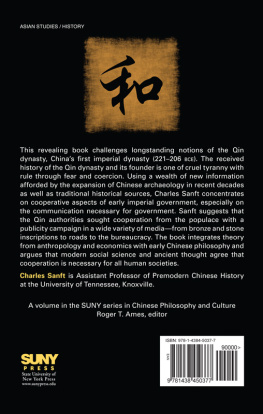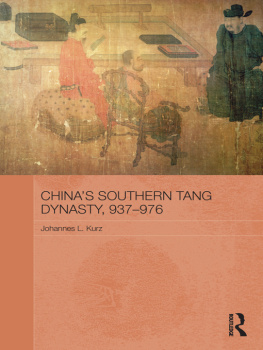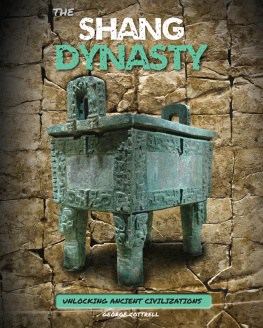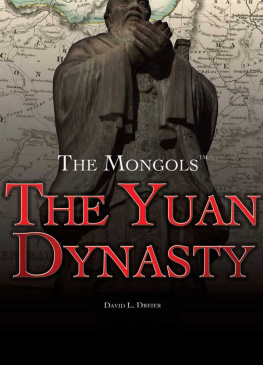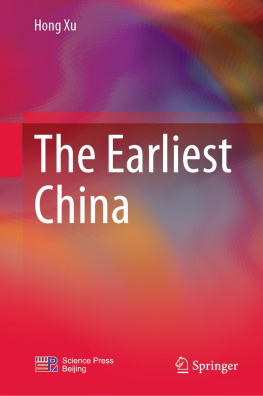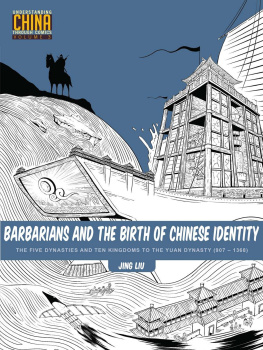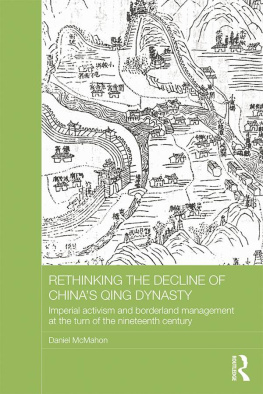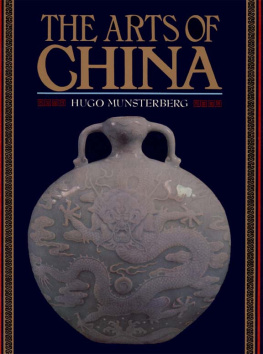Communication and Cooperation
in Early Imperial China
SUNY series in Chinese Philosophy and Culture
Roger T. Ames, editor
Communication and Cooperation
in Early Imperial China
Publicizing the Qin Dynasty
Charles Sanft
Published by State University of New York Press, Albany
2014 State University of New York
All rights reserved
Printed in the United States of America
No part of this book may be used or reproduced in any manner whatsoever without written permission. No part of this book may be stored in a retrieval system or transmitted in any form or by any means including electronic, electrostatic, magnetic tape, mechanical, photocopying, recording, or otherwise without the prior permission in writing of the publisher.
For information, contact State University of New York Press, Albany, NY
www.sunypress.edu
Production by Diane Ganeles
Marketing by Kate McDonnell
Library of Congress Cataloging-in-Publication Data
Sanft, Charles.
Communication and cooperation in early imperial China : publicizing the Qin dynasty / Charles Sanft.
pages cm (SUNY series in Chinese philosophy and culture)
Includes bibliographical references and index.
ISBN 978-1-4384-5037-7 (hardcover : alk. paper)
1. ChinaHistoryQin dynasty, 221207 B.C. 2. ChinaPolitics and government221 B.C.220 A.D. 3. CommunicationPolitical aspectsChinaHistoryTo 1500. I. Title.
DS747.6.S26 2014
302.20931'09014dc23
2013015890
10 9 8 7 6 5 4 3 2 1
To Hsiu-yi
Contents
Acknowledgments
Many colleagues and friends assisted me in writing and revising this book. In order to avoid giving too long a list here, I name a limited number and hope that those not mentioned will understand and know that my gratitude extends to them as well.
Reinhard Emmerich gave me much advice and support over the course of this project, as so often before. Tomiya Itaru provided vital assistance and textual resources. Yuri Pines, with characteristic generosity and acuity, read the entire manuscript more than once and offered many suggestions for its improvement. I am greatly indebted to Mark Edward Lewis and Robin D. S. Yates for their comments on earlier drafts. Finally, I thank Maxim Korolkov, Cameron Moore, and Gideon Shelach, who also read and commented upon the text.
The Institute for Advanced Study (Princeton), the Starr Foundation East Asian Studies Endowment Fund, and the Japan Society for the Promotion of Science provided financial support for this project. The University of Tennessee Exhibit, Performance, and Publication Expense Fund contributed to publication expenses.
I submitted a version of this project as Habilitationsschrift at the University of Mnster in 2011. The Journal of Ritual Studies 22.1 (2008) published an early version of
Introduction
This book treats communication and cooperation in the function of political power in early imperial China, particularly under the short-lived Qin dynasty (221207 BCE). In essence I am interested in the collective decision of a group to obey a government and respect its dominion. I argue creating common knowledge among the population through communication in multiple media was a necessary part of ruling processes in early imperial China and helped solve the coordination problem presented by the unified empire. Through their active and innovative communication, the Qin dynasty resolved these problems so well that the echoes of their success are still ringing today.
The Qin dynasty was the first imperial dynasty in China. The famous First Emperor of Qin (Qin Shihuang , r. 221210 BCE) established the empire by uniting formerly separate polities to create a new state, a process that lasted years and ended in 221 BCE. He governed a territory much larger than any preceding sovereign of the area we now call China. The rulers of Qin confronted a new situation, and they adapted existing practices and technologies to meet its exigencies.
The Qin were obsessedalready before unificationwith making things as big as possible. As such, I hope the Qin case will be amenable to comparison with later dynasties in future studies. If nothing else, the tireless activity of the Qin dynasty makes it an interesting case study.
Despite my primary focus on the Qin, I draw from texts dating to the time before and after that period. This is necessary and proper: necessary because so little has been transmitted that links directly to the dynasty, and proper because the underlying ideas and forms of government inevitably grew out of what went before and reverberated in what came after.
The available sources do not directly relate the views of the common population, and as such the voices of ordinary inhabitants of the early Chinese realm are effectively lost. The study of material culture in conjunction with textual sources offers one way to counter the limitations of the textual record. shows that aspects of those explanations are untenable. It also provides a way to make reasonable inferences about the role of the common population in government, which required their cooperation in various forms as well as the necessity of specific kinds of communication for that cooperation.
This theoretically informed approach recognizes the necessity of cooperation, and not coercion, as the basis of human society. Each member of a cooperating group is a strategic decision-maker whose individual choices, together with the choices of others, translate into high-level effect. Each individual member has power, which is limited and yet real. This was the case in early China as in other societies.
Theoretical work on communication, cooperation, and power allows me to draw new conclusions about what was going on during the years of Qin reign and explain the success, however short-lived, of Qin rule under the First Emperor. This analysis entails study of what Vivienne Shue refers to as the social intertexture that forms the stuff of political life, encompassing all fields of the social sciences and requiring simultaneous attention to detail and to overarching pattern. The conclusions I reach challenge current scholarly consensus on early China in significant ways.
Legacy Approaches
Previous accounts of imperial power in early China generally fall along a spectrum between two poles. At one end are those that stress the theoretically absolute authority of the ruler in imperial China. Those at the other end of the spectrum accept that proposition in the abstract, but they give greater weight to the constraints, especially practical constraints, that inhibited the exercise of the sovereigns authority. Writers all along this spectrum present power in early imperial society as flowing from one part of society outward and downward.
Most historians agree that the emperor was theoretically the ultimate power and the wellspring of state authority in dynastic China. Ray Huang describes the emperor as residing atop a pyramid, the source of power and the final authority on earth.
Victoria Tin-bor Hui has written about state formation under the Qin dynasty. She asserts that Qin imperial rule was theoretically absolute, but that the available technology prevented full realization of this theory. She further suggests that the First Emperor actively enlisted the aid of the populace before unification, when he needed their support. Afterward, she says, the imperial court entered into a state of war with society. Hui attributes tremendous influence to the changes carried out under the Qin, crediting them both with establishing a more unified culture as well as what she calls the authoritarian tradition in China.

